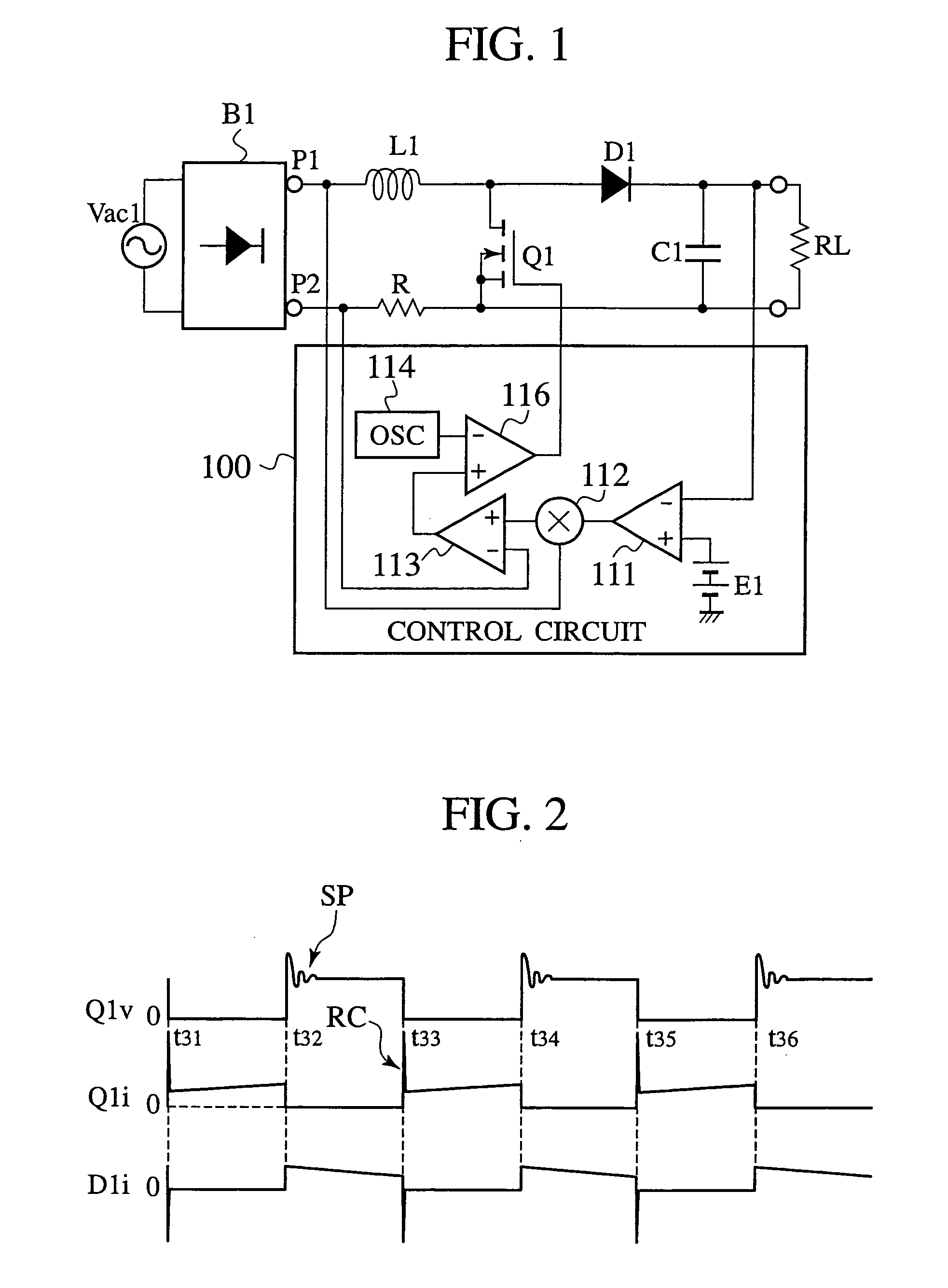Power factor impoving circuit
a technology of power factor and impoving circuit, which is applied in the direction of electric variable regulation, process and machine control, instruments, etc., can solve the problems of increasing the loss of the switch q, increasing the loss of the cr absorber, and increasing the loss of the switch, so as to achieve low noise and high efficiency
- Summary
- Abstract
- Description
- Claims
- Application Information
AI Technical Summary
Benefits of technology
Problems solved by technology
Method used
Image
Examples
first embodiment
[0056] A power factor correction circuit of a first embodiment includes a zero-current switching reactor connected to a main switch in series to allow the main switch to achieve ZCS (zero-current switching) during a turned-on state for thereby reducing losses resulting from a recovery cycle of a rectifying diode such that current gradually changes for thereby performing switching operations at high efficiency and low noises.
[0057]FIG. 3 is a circuit structural view of the power factor correction circuit of the first embodiment. In FIG. 3, a full wave rectifier circuit B1 is connected to an Alternating current power-supply Vac1 to rectify an Alternating current power-supply voltage, received from the Alternating current power-supply Vac1, into a DC voltage that is applied to a positive electrode output terminal P1 and a negative electrode output terminal P2.
[0058] Connected between the positive electrode output terminal P1 and the negative electrode output terminal P2 of the full w...
second embodiment
[0088]FIG. 10 is a circuit structural view of a power factor correction circuit of a second embodiment. The power factor correction circuit of the second embodiment, shown in FIG. 10, differs from the power factor correction circuit of the first embodiment, shown in FIG. 3, in that the ZCS reactor L2 is connected between the booster reactor L1 and the diode D1. The ZCS reactor L2 may be structured with a leakage inductor between the booster winding 5a and the wind-up winding 5b of the booster reactor L1.
[0089]FIG. 11 is a structural view showing a structure of the booster reactor L1 provided in the power factor correction circuit of the second embodiment. The booster reactor L1, shown in FIG. 11, which has a central leg 30c and side legs 30a, 30b, includes a core (iron core) 30 composed of E-shaped core elements, each made of magnetic material, in which a magnetic circuit is formed. The core 30 is made of a magnetic body such as ferrite having high permeability with less iron losse...
third embodiment
[0105]FIG. 13 is a circuit structural view of a power factor correction circuit of a third embodiment. The power factor correction circuit of the third embodiment contemplates to render the power factor correction circuit of the second embodiment, shown in FIG. 10, operative such that the switch Q1 executes the ZCS operation during a turned-on period while, at the same time, collecting electrical charge of a snubber capacitor C2 and permitting the switch Q1 to execute ZVS (zero-voltage switching) operation during turned-off of the switch Q1. This enables reduction in losses resulting from the recovery of the rectifying diode and permits the electric current to slowly change, enabling switching operation at high efficiency with low noises. That is, by charging the snubber capacitor C2 via a diode D5 when the switch Q1 is turned off, the rising of the voltage of the switch Q1 is alleviated to decrease losses during the turned-off state of the switch Q1 while minimizing the occurrence ...
PUM
 Login to View More
Login to View More Abstract
Description
Claims
Application Information
 Login to View More
Login to View More - R&D
- Intellectual Property
- Life Sciences
- Materials
- Tech Scout
- Unparalleled Data Quality
- Higher Quality Content
- 60% Fewer Hallucinations
Browse by: Latest US Patents, China's latest patents, Technical Efficacy Thesaurus, Application Domain, Technology Topic, Popular Technical Reports.
© 2025 PatSnap. All rights reserved.Legal|Privacy policy|Modern Slavery Act Transparency Statement|Sitemap|About US| Contact US: help@patsnap.com



